Women win the vote – gender inequality remains
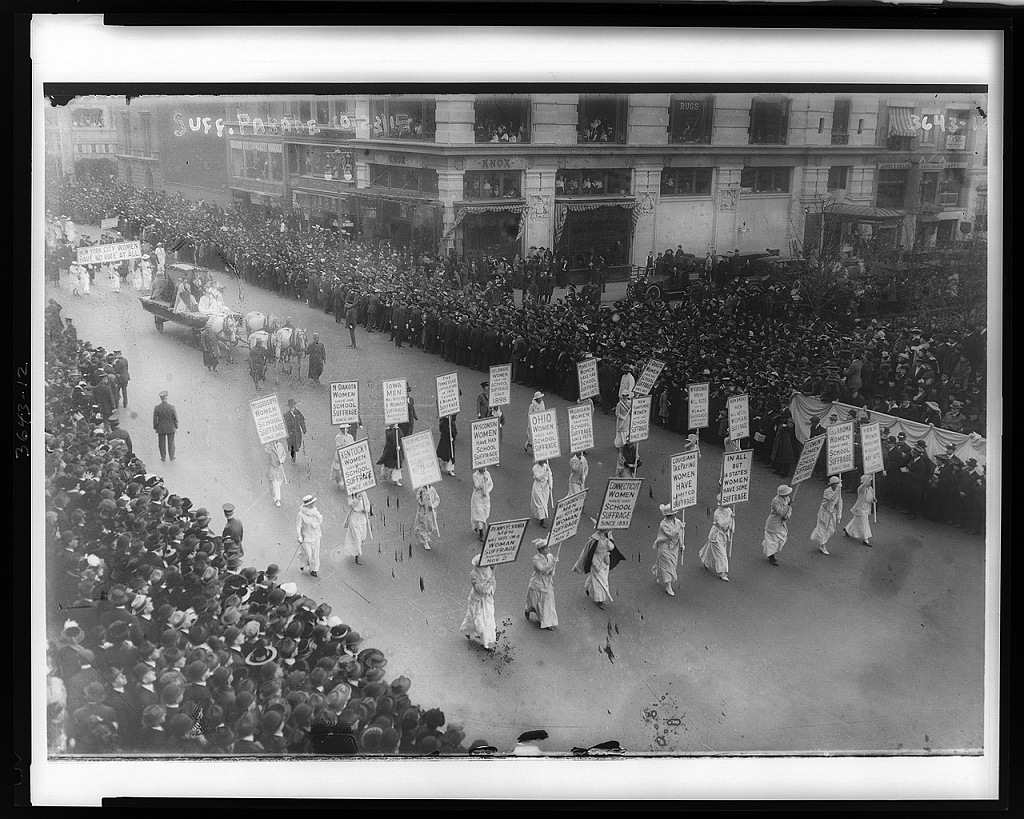
Suffragists marching, probably in New York City in 1915. Photo from Library of Congress.
The 19th Amendment to the U.S. Constitution granted American women the right to vote on August 18, 1920. The amendment became law on August 26, 1920, after Secretary of State Bainbridge Colby signed the official document certifying the successful ratification.
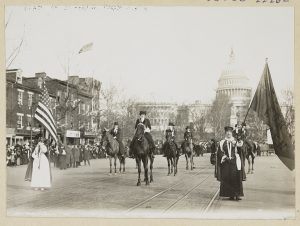
Women suffragists marching on Pennsylvania Avenue led by Mrs. Richard Coke Burleson (center on horseback); U.S. Capitol in background. Mar. 3, 1913. Photo from Library of Congress.
On November 2, 1920, for the first time, more than 8 million women across the U.S. voted in elections. An amendment to the U.S. Constitution requires 2/3 of the states to ratify the amendment. Of note, it took more than 60 years for the remaining 12 states to ratify the 19th Amendment, with Mississippi being the last state to do so on March 22, 1984. (Source: History)
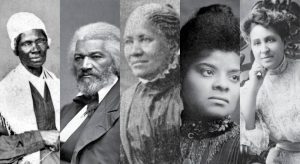
Some of the leading figures of color in the suffrage movement were left to right, Sojourner Truth, Frederick Douglass, Francis Ellen Watkins Harper, Ida B. Wells, and Mary Church Terrell. Photo by Meghan Smith/Creative Commons. Read more at 5 Essential Black Figures in the Women’s Suffrage Movement”.
The women’s right to vote came two years after the end of World War I. While historians question and debate how central World War I was to women achieving suffrage, it certainly brought the injustice to the forefront.
“Whoever denies that woman’s suffrage is not only an appropriate subject for discussion at this time, but an imperative war measure, is ignorant of the causes which led us into the war and the aims for which we are fighting in the war,” said Carrie Chapman Catt, a leading suffragette and founder of the League of Women Voters, would say the following year. She added that if this was truly a war for democracy and against autocracy, the United States could hardly continue to disenfranchise half its population by denying them the right to vote
Elizabeth Hommowun, current Union Ph.D. student and graduate of the UI&U’s Master of Arts program with a major in Literature and Writing degree, is exploring female experiences during World War I. She asks the following questions: Why has the 21st century entered its second decade with the female narrative of this war staying as static and narrow as it had been 100 years ago? Are we still painting women in certain roles because of gender norms of yesteryear? Are we still mired in ideas from 100 years ago?
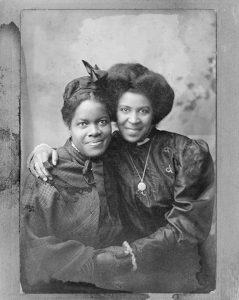
Nannie Helen Burroughs (left) was a national leader within the Woman’s Convention of the National Baptist Convention, many of whose members supported women’s suffrage. Burroughs later became part of an important Washington, D.C., network of African American women. Photo from Library of Congress.
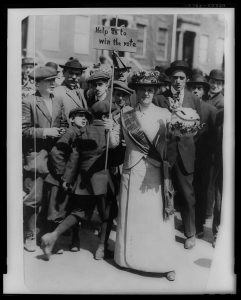
Help us to win the vote. Suffragist, “Mrs. Suffern,” holding sign; crowd of boys and men behind. 1914. Photo from Library of Congress.
“Here is what articles and books will tell you: Women had a role during The Great War. They had always had a ‘place.’ Women were already a part of the workforce. You would find female police officers patrolling the city hotspots for undesirable behavior. They were continuing to develop the work of the Suffrage Movement,” said Elizabeth. “They were even part of the military. A point of fact is that the female experiences during World War I were as diverse and dynamic as any frontline soldier attempting to survive the conflict.”
In an article by Abigail Higgins titled “American Women Fought for 70 Years. It Took WWI to Finally Achieve It,” she points out that more than nine million women helped with the war effort, outnumbering the almost five million men who served. Women saw combat as nurses, ambulance drivers, and Salvation Army front line runners who delivered hot coffee and refreshments. Women served in the Navy in areas as mechanics, munition workers, and as translators. A staggering eight million women volunteered with the Red Cross. Librarians erected makeshift libraries in camps and distributed nearly 10 million books and magazines.
Elizabeth points out that, “Americans have a fascination with the soldiering aspect of war and women are often not seen as important. Today there are few movies about women in war but we know women are fighting; we just do not represent their experiences on the same scale. It’s 2020 and viewers are still drawn to that stereotype.”
Theorist Janet Staiger is helping Elizabeth with how we should remember these women. “Staiger’s work helps me to understand the intersection of film, television, and reception. It’s about exploring how we consume popular media, like television and film, to contextualize or understand historical events. So, if we examine the way in which women are portrayed in stories about war, or the Suffrage movement in this case, what potential message is either being displayed or received by the viewer? It’s important to examine the narratives we consume,” said Elizabeth.
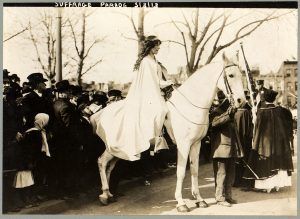
Inez Milholland Boissevain, wearing white cape, seated on white horse at the National American Woman Suffrage Association parade, March 3, 1913, Washington, D.C. Photo from Library of Congress.
As a female scholar, teacher, and citizen, Elizabeth says this is important because we are still grappling with notions of power, gender, and representation. “Here we are, 100 years after women won the right to vote, and there are still gender inequalities to overcome, including the wage gap. It seems obvious to point out, but if all of these years have passed, and there is still work to be done, how could someone suggest that sharing the stories of the women who have gone before us to fight for equality is not important?”

Elizabeth Hommowun
Elizabeth is a Disability Services Coordinator and academic coach at Illinois College. Born and raised in Illinois, she chose Union for her M.A. and Ph.D. because the programs have allowed her to develop as a scholar within her discipline and create learning experiences catered to her research interests. In addition to her doctoral studies at UI&U, she shares her life with her husband Jeremy and puppy Hazel. You can learn more about Elizabeth at LinkedIn.
Editor’s note: The suffrage movement was a decades-long battle that took many years and many people to finally win the right for American women to vote. To learn more:
- Watch the PBS documentary “The Vote”
- Go to the History website for historical overviews of the movement.
- Read “5 Essential Black Figures in the Women’s Suffrage Movement” by Meghan Smith, that points out the conflicting priorities between white suffragists and suffragists of color, many of whom viewed their activism for women’s suffrage as intertwined with their efforts to attain racial justice caused tension within the movement.
- Visit “The 2020 Women’s Vote Centennial Initiative” to learn more and explore the suffragist biography articles.
Learn more about Union Institute & University and the opportunities to complete your degree or start a new career at this link.